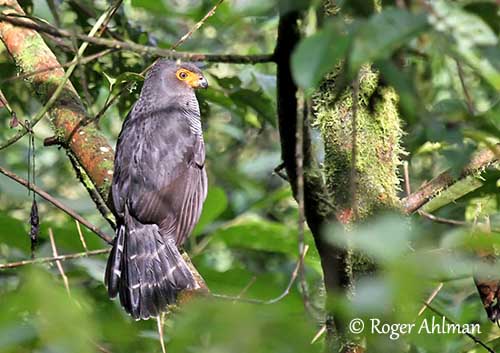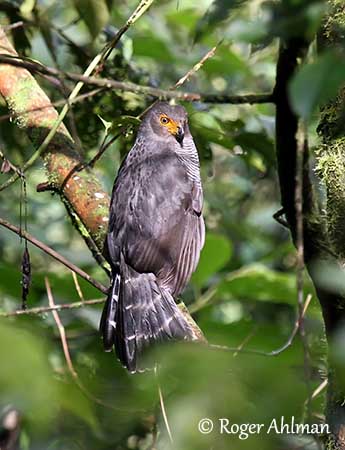
Fr: Carnifex barré
Ang: Barred Forest-Falcon
All: Sperberwaldfalke
Esp: Halcón-montés Agavilanado
Ital: Falco golarossa
Nd: Gestreepte Bosvalk
Sd: Strimmig skogsfalk
Port (Brésil): Falcão-caburé
Photographer:
Roger Ahlman
Pbase Galleries Peru and Ecuador
Text by Nicole Bouglouan
Sources:
HANDBOOK OF THE BIRDS OF THE WORLD Vol 2 by Josep del Hoyo-Andrew Elliot-Jordi Sargatal - Lynx Edicions - ISBN: 8487334156
A GUIDE TO THE BIRDS OF MEXICO AND NORTHERN CENTRAL AMERICA by Steve N. G. Howell, Sophie Webb - Oxford University Press - ISBN: 0198540124
A GUIDE TO THE BIRDS OF COLOMBIA by Steven L. Hilty and William L. Brown - Princeton University Press – ISBN 069108372X
BirdLife International (BirdLife International)
The Peregrine Fund – World Centre for Birds of Prey
Global Raptor Information Network - Working to Conserve Birds of Prey in nature
Ecology.Info - Sympatric Forest-Falcons of the Genus Micrastur
Wikipedia, the free encyclopaedia
SORA Searchable Ornithological Research Archive (Blair O. Wolf)
El Zoológico Electrónico (Damisela)
Barred Forest-Falcon
Micrastur ruficollis
Falconiformes Order – Falconidae Family
INTRODUCTION:
The Barred Forest-Falcon, as other members of genus Micrastur, has short, rounded wings and long graduated tail, allowing the bird to fly in the dense forest. Endemic to the tropical forests of America, this one has grey (here displayed) and rufous morphs. Six subspecies are currently recognized.
DESCRIPTION OF THE BIRD:
Biometrics:
Length: 33-38 cm
Wingspan: 50-60 cm
Weight: M: 160-167 g – F: 195-230 g
The adult male of grey morph has dark slate-grey upperparts. The long tail shows usually three narrow white bars and white tip.
The underparts are paler. Chin and throat are pale grey. Breast, belly, undertail coverts and underwings are white, finely barred with black, more heavily barred on the breast and body sides, whereas belly and vent are almost pure white. The undertail feathers are blackish with white narrow bars.
The head is slate-grey.

The adult male of rufous morph shows similar pattern, with rufous instead of slate-grey colour. It differs by head sides, nape, back, throat and chest which are cinnamon-rufous. The underparts are white, barred black.
The head is rufous.
In both morphs, we can see orange-yellow cere, lores and conspicuous eye-ring. The bill is blackish. The eyes are dark yellow to pale brown. Legs and feet are yellow.
The female resembles male but she is larger, sometimes with brownish tinge, according to the race, and she may be more densely barred than male.
The immature is dark brown above with speckled white rump, and varies from white to cinnamon-buff on the underparts. The fine black bars are widely spaced. It may show whitish half collar on the nape.
SUBSPECIES AND RANGE:
The Barred Forest-Falcon occurs in tropical and subtropical parts of America, from Mexico, south through South America to Colombia, Ecuador, Peru and Bolivia, northern Argentina, Paraguay and Brazil.
The Barred Forest-Falcon has six subspecies which differ in size and especially the tail length, in density of barring, and rather grey or rufous colour of underparts. There are: M.r. guerilla, M.r. interstes, M.r. zonothorax, M.r. concentricus, M.r. ruficollis and M.r. olrogi.
HABITAT:
The Barred Forest-Falcon frequents humid and moist tropical forest, varying from mature, second-growth, tidal swamp and gallery-forests to forest edge habitat, according to the range.
It is often seen up to 2500 metres of elevation, rarely higher.
CALLS AND SONGS: SOUNDS BY XENO-CANTO
The Barred Forest-Falcon’s usual call is a series of sharp barks, as those of a small dog. This call is frequently uttered at dawn and dusk, at short intervals.
It also utters a kind of slightly laughing series “cah cah cah-cah-cah” when excited, like a nasal, chicken-like cackle.
BEHAVIOUR IN THE WILD:
The Barred Forest-Falcon feeds mainly on lizards, birds and small mammals, but also arthropods, mice, bats, frogs and snakes. The birds include Tinamou, pigeons, motmots, toucanets, robins, warblers and flycatchers. They regularly follow army ants swarms (Eciton burchelli).
It often hunts from a perch, waiting for a prey. When the prey is detected, it performs a brief flying pursuit.
It also follows army ants, and may attack the other birds which also follow the ants. It often runs after small preys which are flushed by the ants.
It is usually concealed within the forest, at low to mid-level, and it is difficult to detect, except by the voice. It usually avoids flying across open areas.

During the breeding season, male and female performs courtship displays, including callings before the sunrise, and courtship-feeding by the male. It is often seen solitary or in pairs. Pair bonds last more than one season.
The Barred Forest-Falcon is sedentary in its range.
Its flight is fast and agile, and it often performs aerial pursuits. It does not soar. It flies quickly through the forest, thanks to the short wings.
REPRODUCTION OF THIS SPECIES:
The breeding season varies, according to the range.
The Barred Forest-Falcon nests in natural cavities in trees, and may reuse the same nest for several years. It is placed under the dense canopy cover, and relatively high in tree, at about 12 to 23 metres above the ground. The entrance is fairly small, about 15 cm wide, in order to avoid predation.
The female remains at nest and defends it against competitors such as toucans and parrots.
She usually lays 2 to 3 eggs. A second clutch can replace the first if there is nest failure. The incubation lasts about 33 to 35 days, usually by the female alone, but she is fed by the male near the nest.
The young fledge about 35 to 44 days after hatching, (38 days in average). The young begin to catch arthropods on the ground about two weeks after fledging. One week later, they follow army ants and catch lizards. They begin to chase birds five weeks after fledging, and the male reduces the number of preys brought to the young.
The male delivers all the food during the incubation and the nesting periods.
PROTECTION / THREATS / STATUS:
The Barred Forest-Falcon is relatively abundant in Amazonian forests, and in most parts of the range. This species is suffering habitat loss throughout its range, but it is able to adapt to new habitats. However, the population is suspected to decline slowly.
But currently, the Barred Forest-Falcon is evaluated as Least Concern.